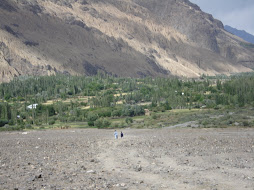Since the inception of Pakistan in 1947 and Chitral State’s joining the federation in 1948, Chitral remained an isolated and impoverished part of the country’s Northwest Frontier Province (NWFP). In political terms, no high profile government functionary either at the provincial or federal level had ever paid a visit to the region. Geographically, it always remained cut off from the rest of the country for six months in a year due to heavy snow on the Lowari Pass, avalanches taking several precious human lives every year. Internally, in the absence of road links, people had to walk for days on pony tracks from their far flung villages to Chitral town to buy the daily necessities for survival.
Economically, people had just survived a famine lasting through the years 1969 to 1971. I can still recall the arrival of the grain which became known to the local population at that time as amricayi, referring to the almost rotten corn stock that had become available to them in quantities, barely enough to survive on. The severity of food shortage was such that a man from a far flung village after waiting several days in Chitral town and failing to buy a few kilograms of barley, corn, wheat, rice or any kind of pulses on which his family could survive, took his life by throwing himself into the freezing Chitral River. I, still remember as a high school student in Chitral town, spending many lunch breaks, after school and on Sundays writing applications for the numerous illiterate villagers to get approval from the Deputy Commissioner’s and Assistant Commissioner’s offices to purchase grain and acquiring the approved amount of grain from the tahsildar, a government functionary responsible at the time for the grain storehouse. As a boarder at the Ismaili Hostel, (which was destroyed by a politically motivated mob in July 1982) I was one of the privileged students to have been provided with accommodation and food.
Educationally, by 1976 a few middle schools located in each tahsil (an administrative unit like a ward or county within a district) had been upgraded to high school (grade ten) but practically it was the high school Chitral town from where most grade ten students graduated. However, the new government, first popularly elected since the creation of Pakistan, had expanded primary education and upgraded some to higher levels and commissioned the Chitral college (grade twelve at that time) now Degree College. Furthermore, the government, for the first time, had established scholarships for students to study in the big urban cities of Pakistan. Female education had yet to be recognized as a priority.
In the area of health, apart from the two hospitals, one in Drosh and the other in Chitral town, and a few dispensaries at the tehsil level, there was hardly any government health facility to my recollection. A vast majority of the population relied on traditional herbal medicines to cure their diseases. Many would seek relief from pain and health recovery in prayers and amulets. One of the consequences of lack of health care facilities was opium addiction of a large number of people who first used it as a pain reliever and then got addicted to it with devastating results for their families; selling off properties to meet the expenses of addiction.
Chitral Today
Apart from the spiritual significance for the Ismaili Muslims in Chitral, the visit of the Imam accompanied by the Prime Minister was symbolic in the sense that it heralded the Ismaili Imamat institutions, which were yet to come to the region, and which would work with those of the government departments to change the deplorable conditions of Chitral as described earlier. This unfolded in many areas of development.
Five years following the visit, the Aga Khan Rural Support Program (AKRSP) was launched in the region, which since then has provided employment opportunities to hundreds of people, men and women, constructed numerous link roads, built irrigation channels bringing vast areas of barren lands with no water at all and lands with insufficient water supply into productive cultivable use, and planting millions of fruit trees and trees for reforestation halting the devastating effect of the deforestation caused by the lucrative profiteers, the loggers legally and illegally. Over the years it has supported numerous villages in building hydro power projects to provide electricity to their houses, and most importantly it has enabled the communities to build their organizational capacity through the development of social organizations, thus unleashing their creative energies to seek solutions to their communities’ problems. Chitral is greener today than one could have imagined in 197, it is producing marketable products such as fruits and potatoes in fairly large quantities, trading them not only within Chitral, but also in Pakistan’s urban centers. AKRSP’s contribution in this regard has been pioneering.
From 1960s to early 1980s, while government resources were directed towards expansion of education for boys, the Aga Khan Education Service (AKES) focused on girls’ education. At the time when the AKES opened its first school for girls in Chitral in early 1980s, there was barely any female literacy and today Chitral is one of the highest female literacy districts in NWFP due to the significant contribution of AKES schools. Currently, it is running 86 schools from grade one to ten with over 6000 students, the largest non-governmental education provider in the district. As a further step, the AKES has started building two high profile higher secondary schools (grade 12) in upper and lower Chitral. The Professional Development Centre in Chitral town, the construction of which is also underway is another significant institutional development to improve the quality of education in Chitral. Over the years, AKES has trained hundreds of its own and of government teachers through its Field-Based Teacher Development Program, improved their language skills through its language Enhancement programs (LEAP and SCIP) and has built many quality school buildings through its self-help school construction program. In all its education endeavors, the AKES has involved the local communities drawing on their strength and improving their capacity to manage their community-based schools.
With no institutional presence in Chitral in 1976, the Aga Khan Health Service has now a network of health centers in far flung villages providing prenatal and postnatal child care. It has established two high quality health facilities with trained doctors, nurses, technicians and modern equipment in purpose built, best quality buildings in lower and upper Chitral. In addition to its numerous primary health care programs, the eradication of centuries old health problem, the goiter, a swelling of the thyroid gland in the neck due to iodine deficiency, is a remarkable achievement. The Aga Khan Planning and Building Service’s achievements in improving the living conditions through innovative and low cost strategies are of no less significance.--Courtesy Hunza Times
Tuesday, October 28, 2008
Subscribe to:
Post Comments (Atom)
Awesome and rugged

Beauty of Chitral

Kishmanja, a beautiful village in Yarkhun valley
Lush green

DIZG: threatened by floods

The legendary village of Ayun in Chitral

On way to Bumburet
Dizg, Yarkhun

Blog Archive
-
▼
2008
(195)
-
▼
October
(50)
- Sit-in staged against delay in Sheshi power house ...
- Govt warned against price hike
- Postgraduate college still a pipe dream in Chitral
- Severe food crisis may hit Chitral
- SELF HELP: Life On The Wrong Side
- Chitral seminar calls for protection of women's ri...
- Education, developmet in Chitral
- Aga Khan's visit still not confirmed
- Chitral: the secrets of my peace!
- Brep: power house project hits snags
- CM okays uplift projects for Chitral
- Work on Yarkhun bridge begins
- NBF readers' club scheme coming to Chitral
- Met official killed in Chitral
- Eliminating women trafficking our collective respo...
- Face of man accused of women trafficking blackened...
- Drosh residents protest power outages
- Rumi’s thoughts can bring stability to world
- Aga Khan's visit to Chitral - Letter 2
- Aga Khan's visit to Chitral -Letter 1
- Lowari tunnel opening to be a gigantic step, says NHA
- Arrangements for Lowari festival reviewed
- Widow's allegations denied
- Proposed Lowari tunnel festival - Letter
- Multi-stakeholder forum - Letter
- Arrangements for Lowari tunnel festival discussed
- Aga Khan to visit Chitral in mid-November?
- Body on women's rights formed in Chitral
- US drones fly over Chitral?
- Five cases of violence against women in Chitral in...
- Bids for trophy hunting invited
- Over 3,000 Benazir income support cards distribute...
- Preparations to welcome Aga Khan in full swing in ...
- Anti-polio drive begins in Chitral
- NHA agrees to open Lowari tunnel in winter
- MNA justifies supporting PPP
- Timely completion of uplift projects ordered
- Impersonator arrested
- Opening of Lowari tunnel for light traffic demanded
- Shortage of technical staff mars uplift in Chitral
- Bajaur blockade to hurt Chitralis too
- Upper Chitral residents to pay bills locally
- Chitral colleges lack hostel facilities
- Over 75,000 children to be administered polio drops
- Trade corridor: paradigm shift we’ve been waiting ...
- Lowari tunnel will be opened this winter
- Woman commits suicide in awi
- Islamabad-Chitral flights still being mismanaged
- JI leader sees conspiracy to establish Ismaili state
- Most Chitralis unable to go home on Eid due to hig...
-
▼
October
(50)
About Me

- Zar Alam Khan Razakhel
- Village Dizg, Yarkhun valley, Chitral, Pakistan
- I blog at http://chitraltoday.net (ChitralToday) about Chitral, its people, culture, traditions and issues. I have been writing about Chitral since 2000. Chitral is a scenic valley in the extreme north-west of Pakistan.
No comments:
Post a Comment